Contents
- 1.1 Introduction
- 1.2 What is a Hoop Structure?
- 1.3 Advantages
- 1.4 Disadvantages
- 1.5 Planning and Managing the Structure
- 1.6 Planning Details
- 1.7 Environment and Ventilation
- 1.8 Ridge and Sidewall Openings
- 1.9 Endwall Ventilation
- 1.10 Cooling
- 1.11 Feed and Water
- 1.12 Managing the Pigs
- 1.13 Managing Solid Manure
- 1.14 Removing Solid Manure
- 1.15 Bedding
- 1.16 Storing Solid Manure
- 1.17 Budget and Labor Issues
- 1.18 Other Considerations
- 1.19 Summary
Authors:
Mark S. Honeyman, Iowa State University;
Frederick Wm. Koenig, MidWest Plan Service;
Jay D. Harmon, Iowa State University;
Don C. Lay, Jr., Iowa State University;
James B. Kliebenstein, Iowa State University;
Thomas L. Richard, Iowa State University;
Michael C. Brumm, University of Nebraska
Reviewers:
Eldridge R. Collins, Jr., Virginia Polytechnic Institute and State University;
Don D. Jones, Purdue University
Introduction
Pork producers in the United States who are looking for lower cost structures for raising pigs have shown a great deal of interest in hoop structures or hooped shelters as facilities for housing market or finishing pigs. Producers need to be aware of the advantages and disadvantages of this type of housing. A number of manufacturers offer these units for sale, but little objective data are available to help producers decide if a hoop structure is a good investment. The information in this publication is intended to help producers and designers resolve some of the issues involved in using a hoop structure. The fact sheet discusses some of the management techniques that hoop structures require, and it presents economic factors that can be used to analyze the alternatives.
What is a Hoop Structure?
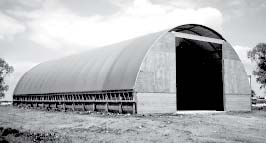
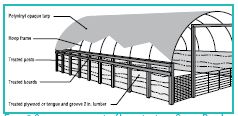
A hoop structure is a Quonset-shaped structure with sidewalls 4 ft to 6 ft high made from treated wood posts and wood sides. Tubular steel arches are fastened to the tops or sides of the posts to form a hooped roof, which is covered with an opaque, UV-resistant, polyvinyl tarp. When used for swine housing, most hoop structures have earthen floors except for a concrete slab feeding and watering area. The earthen portion of the floor is deep bedded and cleaned after each group of pigs is marketed.
Figure 1 shows a typical hoop structure and Figure 2 shows the common components of a hoop structure. Hoop structures are naturally ventilated and should be sited to take advantage of prevailing summer winds.
Advantages
Hoop structures are most beneficial for producers who:
- Want facilities with versatility to match a rapidly changing swine industry.
- Need a short-term structure that can be removed after use or that can be adapted for other uses.
- Want to keep fixed costs low.
- Have limited capital.
- Are not interested in accepting the additional financial risk associated with a large capital investment.
- Prefer to handle solid manure and have the capability to do so.
- Want a working environment with lower levels of manure gases.
- Have the equipment and land resources to harvest crop residue for bedding.
- Prefer a system of production that is less automated and requires more specialized husbandry skills.
- Believe pigs should be reared in an environment with bedding.
- Need a structure built quickly.
Disadvantages
- It is more difficult to observe animals in large groups.
- Hoop pigs may use feed less efficiently.
- Less favorable labor environment during inclement weather.
- Hoop pigs may be slightly less lean than confinement pigs.
- More labor may be needed for hoops than confinement.
- Hoops require large amounts of bedding.
- Labor needs for bedding harvest may conflict with grain harvest labor needs.
- Bedding storage may be used by racoons and other animals that may foster farm-to-farm disease transmission.
- It is difficult to exclude birds and other animals that may carry diseases.
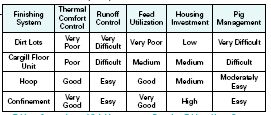
Table 1 shows a comparison of various swine finishing facilities. Hoop structures are a good alternative for producers who are unwilling or unable to invest in confinement facilities but want to move pigs from outside lots or Cargill-type floor units to a facility that has a more manageable thermal environment, that provides better runoff control, and that allows better feed usage.
Planning and Managing the Structure
Structure management issues include the following:
- The structure should be managed as a cold barn.
- Frost-free or no-freeze waterers are necessary.
- Rainfall runoff must be handled in an environmentally satisfactory way.
- Lights are needed if animal monitoring or sorting are performed after dark.
- One watering space should be provided for every 25-40 pigs.
- Extra nipple waterers may be needed in the summer.
- A maintenance schedule should be developed that includes checking the entire structure every 12 months, and checking the tarp for tears and tautness every 6 months.
Planning Details
Producers who decide to build a hoop structure need to treat the construction project as they would any project involving a new structure. Aspects to consider include site selection; proper access to move feed, bedding, and pigs; usefulness within an existing operation; proximity to neighbors; availability of services and utilities; and the possibility of using the structure in conjunction with existing buildings. Provide at least 10 feet of space between multiple hoop structures to allow space for tractors to travel between buildings, snow removal, and drainage.
Hoop structures are naturally ventilated and should be sited to take advantage of the summer prevailing winds. For much of the midwest, the structure is oriented in a north-south direction to take advantage of the prevailing summer winds. Prevailing summer winds should blow into the south end of the building where the feeders and waterers are located and exit on the north.

In a grow-finish hoop structure, a 15- to 25-foot long concrete pad, or approximately 1/4 to 1/3 the length of the structure, is provided for feeders and waterers. This pad should extend the entire width of the structure. In such a location, the pad is sloped 1% to 2% (1/8-inch to 1/4-inch drop per foot of length) to the south, or away from the bedded area. The runoff must be stored and field applied.

A typical hoop structure is 30x72ft and holds approximately 180 head of finishing pigs in one large group. Figure 3 shows a common layout for a grow-finish hoop structure. Stocking density usually is about 12 square feet per pig. Table 2 shows the typical space distribution in a hoop structure used for housing grow finish pigs.
Livestock panels or gates form the endwalls at animal level. To reduce drafts in the winter, these gates can be covered with tarps, sheets of galvanized steel, recycled plastic, or plywood. The bedded end endwalls are closed to reduce winter winds using commercially available tarps or plywood sheets. Many producers close the north end in cold weather, especially in northern climates of the United States. Some producers may close both ends in cold weather; however, closing the structure too tightly can cause more of a problem than leaving it open. In the summer, both ends are totally open, with the steel, plastic, or plywood panels removed from the end gating to increase airflow in the pig zone.
Environment and Ventilation
The primary goal of hoop structures is to protect the animals from the weather. In the summer, the building should provide shade and allow cross ventilation by wind pressure. In the winter, the housing should allow for humidity and draft control. A cold barn with deep, clean, and dry bedding allows the pigs to create a suitable, comfortable microenvironment.
A natural tendency is to try to restrict ventilation to keep warmed air inside the structure. However, restricting ventilation traps the moisture produced by the animals along with the warm air. This creates a situation that can damage the pig’s health.
To reduce risks to animal health from poor air quality, hoop structures must be managed just as any cold, naturally ventilated structure. Do not close the structure too tightly. Do not attempt to manage the structure as a warm barn; it is primarily a shelter. Heat will be given off by the manure pack under the animals to help make them more comfortable.
Because wind is a major force in the ventilation of any naturally ventilated structure, orient a hoop structure to intercept the prevailing summer wind through the feeder end opening. Do not construct a hoop structure where buildings, trees, or other large obstructions block the prevailing summer winds. For most structures, the minimum separation distance from obstructions to the end of the building should be 75ft.
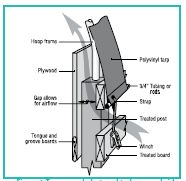
Ridge and Sidewall Openings
Natural ventilation uses openings at different heights to achieve ventilation in the winter. A structure with an open ridge will allow the moist air that builds up to escape through the opening at the top of the structure. Most narrow (<40ft) hoop structures used for swine housing do not have ridge openings but a ridge opening tarp is now available. Ventilation air enters through a continuous space along the sidewall where the tarp is attached see Figure 4) and exits through the ends of the hoop, depending on wind direction. Because openings are not adjusted, the hoop acts mostly as a wind and snow shelter and does not maintain a set temperature.
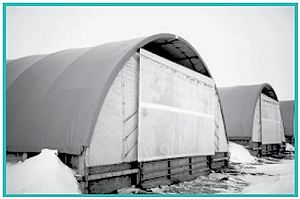
Endwall Ventilation
Hoop structures rely on endwall openings to aid air flow through the structure. The ends are open most of the year. The downwind end is usually closed during harsh conditions in the winter (See Figure 5); the upwind end also may be closed during the harshest part of the winter. A gap at the top of the endwall prevents the building from being closed up too tightly and aids in natural ventilation when the ends are closed. Where hovers or wind baffles on gating are used to reduce drafts, the draft prevention devices must still allow ventilation and moisture removal to occur.
Cooling
Make provisions to cool the pigs for summer heat relief. Many producers add a wetting or sprinkling device. They place these devices at the edge of the concrete apron so any prevailing breeze carries the water over the bedding pack. Pigs digging mud holes in the bedding pack has not been a problem when these wetting devices are managed properly.
Wetting of the pigs should be done using a cycle timer to allow evaporation of water from the pig’s surface to enhance the cooling effect. Careful management is necessary to prevent problems with wet bedding.
Feed and Water
Hoop structures usually use self-feeders placed on the concrete area. In a grow-finish operation, provide a feeder space for every five to ten pigs. A typical 180- to 200-head hoop structure has two or three 12-hole selffeeders and one, fourhole no-freeze waterer. In the summer, additional watering space is necessary and can be provided by one or more nipple waterers.
Managing the Pigs
Pig Performance. Feed intake is often more in hoops than confinement, particularly in the winter. The amount of additional winter feed varies between farms, climate, and seasonal extremes. Typically, for the first one or two uses of a hoop structure, the producer provides the same diet as for pigs in confinement buildings until a clear pattern of elevated feed intake emerges. Some producers are now beginning to adjust diets for nutrient density with an expectation of elevated feed intake. In winter, a good estimate is that 0.3lb more feed will be needed per pound of live weight gain, or about 10% more feed as compared to confinement buildings. In the summer, a good estimate is that there will be no difference or a 0.1lb more feed per lb of gain in hoop structures. For a yearly estimate, use 0.2lb more feed per lb of gain in hoop structures. On the basis of experiences in both winter and summer, backfat is estimated to average 0.1 inch more at the tenth rib for pigs raised in hoop structures compared to pigs raised in confinement. Average daily gain for hoop-housed pigs is as good as that of confinement pigs and may be greater if the pigs are healthier. The deep bedding and additional floor space probably positively affect the social structure and behavior to allow for such a large group size. Behavior research has shown that hoop pigs exhibit fewer stereotypical behaviors that are signs of a stressful environment than confinement pigs. A majority of producers report a three- to four-week marketing range. That is, the time from the sale of the first pig to the removal of the last pig is three to four weeks. With 180 pigs, this usually means that approximately five pigs do not reach minimum market weight. These results are similar to those obtained in confinement operations.
Health. The health of pigs in hoop structures is generally good. Studies report that death loss has been minimal in hoop structures and is often lower than in confinement buildings. Respiratory problems have been minimal. To date, experiences have shown that a wide variety of pig genetics are adaptable to hoop structures. Pathogens could build up in the dirt floor under the bedded pack with long-term use. Roundworms can be an additional long-term health management concern if the pigs are not wormed or parasite free before entering the facility. If parasites become a concern, a layer of soil can be removed and replaced with a new layer with lime added. A routine monitoring program for both external and internal parasites is recommended.
Pig Handling and Management. Because the pigs are in a large group in a bedded setting, it is important to walk through them frequently to check the health status of each pig. It is very difficult to check all of the pigs by looking into the structure. Producers should check their pigs daily. To facilitate animal handling, a hoop structure needs to have a good gating system with some type of sorting area. The gating system must be able to:
- Sort animals for market.
- Hold back smaller animals not going to market.
- Separate sick animals from the larger group. Because of the layout of hoop structures and large group sizes, identifying, removing, and/or treating sick animals can be difficult.
In some instances, hoop structures have been constructed next to an existing concrete pad, and the existing pad has been used for sorting. In other instances, additional expense is necessary to construct a sorting area. Producers report that pigs from hoops sort and load well with adequate facilities. Portable loading chutes are effective for loading market animals if one to three hoop buildings are being used. If an operation has more than three hoop structures, a permanent loading facility is more efficient.
Managing Solid Manure
Before considering a hoop structure, one must carefully plan on how to handle the bedded manure pack. The proper equipment to remove the manure resulting from the bedded pack must be available. If direct application to a field is not possible, then space to stockpile the manure is needed. Knowing the nutrient content of manure is essential for those who have developed a manure management plan for their fields. Because of the drier bedding from hoop structures, the manure will have a higher-carbon/lower-nitrogen status than manure from facilities with semisolid or liquid manure systems.
Removing Solid Manure
The manure/bedding mixture removed from the hoop structure is either directly spread on fields or stored for later use. Typically, there are few custom haulers available that will handle solid manure. If this is the case, a manure spreader, loader, and tractor must be available for on-farm usage. Corn stalks are often used in the midwest for bedding. Corn stalk bedding is not easily handled due to the potential for wrapping on manure spreader beaters. An ordinary skid-steer loader will probably not be sufficient to tear apart the pack for loading.
Most producers agree on 10-15 hours of total labor to clean a hoop structure for 180-200 pigs and spread the material on nearby cropland. The best equipment to remove the bedding pack is a front-wheel assist tractor with a grapple fork attachment on the front-end loader.
Bedding
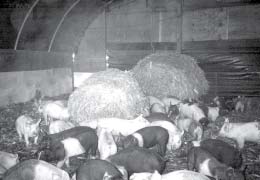
Bedding is one of the keys to the success of hoop structures. The producer must determine how many acres are available to provide residue for bedding and then decide how many of those acres must be harvested to meet bedding needs. Enough bedding must be provided to keep the soil under the bedding pack relatively dry. Pigs establish certain dunging areas throughout the structure. Many times, winter groups will sleep in the north end and along the wooden sidewalls and dung in the space between the bedding area and the concrete slab used for feeding and watering. Additional bedding may be required in that area to prevent the dunging area from becoming sloppy. Large round bales used for bedding are shown in Figure 6.
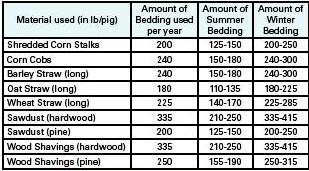
Several materials have been used successfully for bedding although most experiences have been with baled corn-stalks. Table 3 lists other products that can be used, along with the approximate amount of bedding needed In some instances, hoop structures have been constructed next to an existing concrete pad, and the existing pad has been used for sorting. In other instances, additional expense is necessary to construct a sorting area. Producers report that pigs from hoops sort and load well with adequate facilities. Portable loading chutes are effective for loading market animals if one to three hoop buildings are being used. If an operation has more than three hoop structures, a permanent loading facility is more efficient.
Soil conservation. In regions where residue cover is required on highly erodible lands, the harvesting of corn or bean stalks may not be a viable option.
Custom baling. As indicated above, baling, transporting, and storing corn stalks may cost $10-20 per ton. Additional costs are incurred in transporting bales. On-farm baling, while requiring less out-of-pocket expense, is not a low-cost option. Additionally, stalk-baling results in more wear on round balers than does normal hay baling.
Bedding availability. When a wet fall or early snow prevents stalks from being baled in a timely manner, they may become less available and more costly. A situation of this type could require a shift in priorities from doing all of the grain harvesting first to a system of harvesting and baling stalks.
Bedding storage. Bedding baled in the fall and used before the spring generally does not deteriorate if stored outside. However, if stored into the spring and summer, bedding must be protected to prevent reduction in quality. Bales that will be used during spring and summer should be stored under cover on a well-drained area. Bales stored outdoors will lose bedding quality, thereby increasing costs.
Storing Solid Manure
If manure is applied directly to the fields, storage requirements are minimal, but if solid manure is stored after cleaning, then designing a space to safely stockpile the manure is necessary. Knowing the amount of manure to be stockpiled is necessary to properly design the storage area.
As it comes directly out of the hoop structure, the high degree of variability in the bedded pack makes it difficult to predict manure nutrient contributions to crop fertilization needs. Composting is likely to occur if the manure is stored for any length of time and will provide volume reduction of one-third to one-half and nutrient stabilization prior to field application. Such composting will occur with minimal management if the material is piled in windrows about 6ft high and 12ft wide.
The bedding pack composts well. Mixing the material to achieve a higher degree of uniformity can be easily accomplished while building the pile. Place dryer material at the bottom of the pile, and alternate wet and dry layers. Additional mixing, as would occur during turned windrow composting, may offer a benefit in terms of volume and weight reduction, but will also result in more nitrogen loss through ammonia volatilization. Contact your local Cooperative Extension Service for recommendations on composting manure.
There is some concern about nitrogen leaching from storage, especially during high rainfall. In most states, environmental control agencies are concerned about runoff potential and will inspect areas designated for manure storage. Storing manure on a concrete pad can be an effective management tool that will provide a solid base to make manure removal easier and can be designed to safely control runoff from the area.
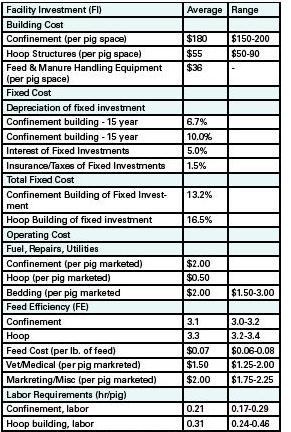
Budget and Labor Issues
Table 4 shows cost ranges for labor, operating, and fixed costs. In addition, carcass quality can affect the price offered by a packer. Knowledge of these items will enable producers to strategically compare hoop buildings to other options. Fixed costs are calculated at 13.2% of total investment for confinement and 16.5% for hoops. Confinement facilities are depreciated over 15 years (6.7% annually), while hoops are depreciated over 10 years (10% annually). An interest rate of 10% is assumed for both systems (5% of initial investment). Bedding cost is at the rate of 200lb of cornstalks per pig. Feed efficiency difference of 0.2 between the hoop and confinement system is based on previous studies and swine producer observations.
Labor Requirements. Labor requirements are a highly variable input to swine production systems. Labor varies from farm to farm depending on the layout, level of automation, age and condition of facilities, and other factors. Table 4 also shows some estimated amounts of labor for various tasks. Frequently, production systems with solid manure are viewed as systems that require more labor than production systems with liquid manure. In hoop structures with full-width end access and large bedding bales handled mechanically, the amount of labor required is comparable to the labor needs of conventional systems. Labor needs with hoop structures are probably slightly more than they are in new, welldesigned confinement systems primarily because large bales of bedding must be hauled and placed into the hooped structure. This difference is estimated at 0.1 hour more per pig.
The type of labor, however, is quite different for hoop structures. It includes bedding the pigs, checking the pigs, and bedding pack clean out. Walking the bedding area daily to check pigs is crucial; with large groups of deep-bedded pigs, consistent observation of pigs is critical for success.
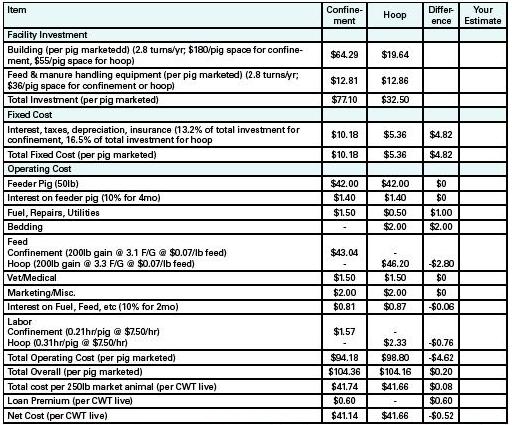
Cost Analysis. Table 5 shows a cost analysis comparing confinement and hoop buildings. Costs vary depending on location and availability of materials, so you are encouraged to prepare your own budget in the Your Estimate column with values that reflect your operation. Use Table 4 to
help estimate your costs.
The comparisons in Table 5 use a cost of $180 per pig space for a confinement system compared to $55 per pig space for a hoop structure. Each system has 2.8 groups of pigs produced per year. Investment in manure and feed handling equipment is the same for each system. Again, depending upon alterations in system design, location, etc., these values may differ for your operation.
Fixed costs are calculated at 13.2% of investment for a confinement facility and 16.5% for the hooped facility. The interest rate is 10% (5% on average investment), with insurance and taxes at 1.5% for both facility types.
Life expectancy, on average, is 15 years for a confinement building. Because the use of hoop structures as swine housing is a relatively new practice, life expectancy data are not complete; the best estimate is that hoop structures will last at least 10 years.
Feed, repairs, bedding, etc., are based on Iowa State University data. The bedding cost is for the rate of 200lb of shredded cornstalks per pig. A 1,200lb bale at $12.00 per bale provides a cost of 1¢ per lb. Interest is at 10%, covering 4 months for the feeder pig and 2 months for the other operating costs excluding labor.
Feed efficiency is 3.1lb of feed per pound of gain in confinement and 3.3lb for the hoop facility; for a difference of 0.2lb more for the hoop structure. Studies have shown an annual difference of 0.1lb to 0.3lb. Location can affect these values, as feed efficiency tends to be affected the most during the winter months in the northern climates. Labor requirements, including manure removal, are assumed to be 12 minutes per pig for confinement and 18 minutes per pig for the hooped structure.
A lean premium of $1.50 per pig is based on less backfat of 0.1 inches for pigs in the confinement system. This would provide a premium of $0.60 per CWT live weight or $1.50 for a 250lb pig.
Other Considerations
For diversified, moderate-sized swine producers, hoop structures offer some additional considerations. The structures are versatile and could be used for alternative purposes, for example, hay, machinery, or grain storage. The hoop structures can be constructed with on-farm labor. The versatility, production flexibility, and low capital costs may result in reduced financial risk. The quality of the work environment is generally good, with no liquid manure and a large volume of naturally ventilated air inside the building. Day-to-day odor is less, and manure can be stockpiled for spreading at appropriate times. However, the added bedding increases the volume of solid manure and requires a different type of manure management than liquid manure. Some bedding may need to be protected from adverse weather for use late in the year. Low cost, high quality bedding must be a high priority for the system. Also, it is unclear whether pathogens or parasites will build up in the soil floor over long periods of use.
Summary
The full impact of new swine housing alternatives such as hoop structures needs to be evaluated for short- and long-term effects. Producers considering a hoop structure need to evaluate initial costs and operating costs for each alternative. They also need to gather as much information as possible about animal performance in different types of housing. Among the major issues that a producer must consider are the following:
- Hoop structures have lower fixed costs and higher operating costs (for example: bedding, labor, feed usage) than totally enclosed housing.
- Hoop structures are versatile and can be used for other applications, such as machinery storage, if not used to house pigs.
- If the tarp covering needs to be replaced before 10 years, tarp replacement costs must be added to cost calculations.
- Because hoop structures have a lower initial cost, producers can test their capability in swine production with a smaller investment.
- Producers who want to erect several hoop structures may find that the volume of crop residue for soil conservation will become a limiting factor.
- Producers who wish to improve their situation with dirt lots or sheds and lots have a low investment opportunity.
The financial information presented in Table 5 suggests that for a particular application, a hoop structure is a competitive alternative system for pork production. Raising pigs in a hoop system requires less capital, more labor, bedding, and slightly more feed than raising pigs in a confinement system. Producers should analyze their costs and compare alternatives. Given similar costs, other factors may tip the building decision to a hoop structure or a totally enclosed building. Personal preference and perceived benefits of one style over another may sway a producer to choose the housing type which is more appropriate for a specific situation. For example, a producer who wants to expand quickly may find a hoop structure to be the best alternative, while another producer might conclude that the longer history and known attributes of totally enclosed housing are more appealing.
Note: This fact sheet is patterned after “Hoop Structures for Grow-Finish Swine”, AED-41, by the MidWest Plan Service, 122 Davidson Hall, Ames, IA, 50011-3080.
Table 1. Comparison of finishing systems. Based on Table 1, Hoop Structures for Gestating Sows, AED-44.
Table 2. Space distribution in a hoop structure used for grow-finish housing. Note: In hot weather, additional waters may be added. Source: Table 1, Hoop Structures for Grow-Finish Swine, AED-41.
Table 3. Estimated amount of bedding needed for pigs in a hoop structure. Source: Table 2, Hoop Structures for Grow-Finish Swine, AED- 41.AED-41.
Table 4. Estimated costs. Based on Table 4, Hoop Structures for Grow-Finish Swine, AED-41.
Table 5. Market swine cost comparison. Based on Table 5, Hoop Structures for Grow-Finish Swine, AED-41.
Figure 1. Typical hoop structure
Figure 2. Common components of hoop structures. Source: Based on Figure 2, Hoop Structures for Gestating Sows, AED-44.
Figure 3. Common layout of a grow-finish hoop structure. Source: Based on Figure 3, Hoop Structures for Grow-Finish Swine, AED41.
Figure 4. Tarp properly fastened to frame and sidewall. Source: Based on Figure 16, Hoop Structures for Gestating Sows, AED44.
Figure 5. Cloed end of hoop during cold weather. Source: Based on Figure 13, Hoop Structures for Gestating Sows, AED44.
Figure 6. Large round bales used for bedding. Source: Based on Figure 13, Hoop Structures for Grow-finish Swine, AED41.
